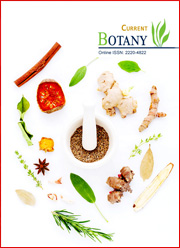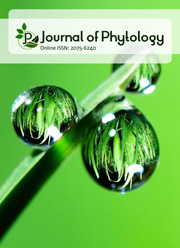Genotypic diversity evaluation for nutritional and grain quality attributes in cultivated rice varieties of Assam
DOI:
https://doi.org/10.25081/cb.2025.v16.9179Keywords:
Indigenous cultivars, Nutrition content, Grain Characteristics, Genetic variability, Correlation, D2 analysisAbstract
A set of fifty rice genotypes mostly of indigenous type and a few improved varieties grown by farmers of Assam were studied to screen for nutritional content, grain characteristics and yield potential. Based on the grain classification system, two cultivars were categorised as small (1.5-2), eleven were medium (2.1-2.5), fourteen had medium slender (2.6-3.0) grain, and eighteen were of slender (>3.0) type; Mahsuri had the highest grain yield per plant (49.64 g). The glutinous type, ‘Bora’ group of cultivars had comparatively the lower content of amylose (2.45-2.76%) with corresponding higher level of amylopectin (97.24-97.55%). A wide variation was observed for protein content, ranging from 3.5% in Amona Bao to 12.26% in Vandana. Manipuri Joha and Badol Sali were found to have the greatest concentrations of iron (466.88 mg/100 g) and zinc (44.8 mg/100 g), respectively. Grain length breadth ratio, volume expansion ratio, iron and protein content showed significant positive correlation with grain yield. High heritability in the broad sense was observed for the traits grain weight, grain length and breadth, length: breadth ratio, volume expansion ratio, iron and zinc. The cultivars were categorized into six clusters based on the Mahalanobis D2 analysis, with cluster VI (739221) exhibiting the highest intra-cluster distance and cluster V with cluster II (27774001) exhibiting the highest inter-cluster distance. The genotypes belonging to the diverse clusters along with the desirable per se performance might be chosen for inclusion as parents in the hybridization program. Comprehensive understanding of the nutrients and grain characteristics and their relationship with grain yield would pave the way for further genetic improvement of quality and yield of rice.
Downloads
References
Anuradha, N., Satyavathi, C. T., Meena, M. C., Sankar, S. M., Bharadwaj, C., Bhat, J., Singh, O., & Singh, S. P. (2017). Evaluation of pearl millet [Pennisetum glaucum (L.) R. Br.] for grain iron and zinc content in different agro climatic zones of India. Indian Journal of Genetics and Plant Breeding, 77(01), 65-73. https://doi.org/10.5958/0975-6906.2017.00009.8
Baishya, S., Pathak, K., Baruah, A. M., & Rathi, S. (2010). Starch and protein profile of hill rice cultivars of Assam. Oryza, 47(3), 237-242.
Bhargavi, B., Suneetha, Y., Kumar, J. A., & Thati, S. (2023). Genetic divergence studies for yield and quality traits in high protein landraces of rice (Oryza sativa L.). Plant Science Today, 10(2), 195-204. https://doi.org/10.14719/pst.2091
Burton, G. W., & Devane, E. H. (1953). Estimating heritability in tall fescus (Festuca arrundinaceae) from replicated clonal material. Agronomy Journal, 45(10), 478-481. https://doi.org/10.2134/agronj1953.00021962004500100005x
Das, G. R. (1997). Evolution of rice with special reference to North East India. Titabor, Assam: Platinum Jubilee celebration, Regional Rice Research Station.
Das, P., Singha, A. D., Goswami, K., & Sarmah, K. (2018). Detection of Nutritionally Significant Indigenous Rice Varieties from Assam, India. Bulletin of Environment, Pharmacology and Life Sciences, 7(4), 59-64.
Faysal, A. S. M., Ali, L., Azam, M. G., Sarker, U., Ercisli, S., Golokhvast, K. S., & Marc, R. A. (2022). Genetic Variability, Character Association, and Path Coefficient Analysis in Transplant Aman Rice Genotypes. Plants, 11(21), 2952. https://doi.org/10.3390/plants11212952
Ferdous, N., Elias, S. M., Howlader, Z. H., Biswas, S. K., Rahman, M. S., Habiba, K. K., & Seraj, Z. I. (2018). Profiling Bangladeshi rice diversity based on grain size and amylose content using molecular markers. Current Plant Biology, 14, 56-65. https://doi.org/10.1016/j.cpb.2018.09.002
Guha, B. C., & Mitra, N. R. (1963). Studies on the consistency of thiamine and protein contents of pure-bred strain of rice. Annals of Biochemistry and Experimental Medicine, 23(2), 69-72.
Hasan, N. A., Rafii, M. Y., Harun, A. R., Ali, N. S., Mazlan, N., & Abdullah, S. (2022). Genetic analysis of yield and yield contributing traits in rice (Oryza sativa L.) BC2F3 population derived from MR264× PS2. Biotechnology & Biotechnological Equipment, 36(1), 184-192. https://doi.org/10.1080/13102818.2022.2060760
IRRI. (2013). Standard evaluation system for rice. (5th ed.). Manila, The Philippines: IRRI.
John, R., Bollinedi, H., Jeyaseelan, C., Padhi, S. R., Sajwan, N., Nath, D., Singh, R., Ahlawat, S. P., Bhardwaj, R., & Rana, J. C. (2023). Mining nutri-dense accessions from rice landraces of Assam, India. Heliyon, 9(7), e17524. https://doi.org/10.1016/j.heliyon.2023.e17524
Johnson, H. W., Robinson, H. F., & Comstock, R. E. (1955). Estimates of genetic and environmental variability in Soyabeans. Agronomy Journal, 47(7), 1314-1318. https://doi.org/10.2134/agronj1955.00021962004700070009x
Juliano, B. O. (1972). Physico-Chemical Properties of Starch and Protein and Their Relation to Grain Quality and Nutritional Value of Rice. International Rice Research Institute Rice Breeding (pp. 389-405) (Proceedings of Symposium Los Baños).
Kalita, T., & Hazarika, J. (2022). Morphological study, nutritional value and phytochemical estimation of four indigenous rice (Oryza sativa L.) varieties of Assam, India. Food Research, 6(1), 196-203.
Kumar, R., Ram, M., Heera, P. K., Murali, S., & Kumar A. S. (2023). Analysis of Genetic Variability, Heritability and Genetic Advance for Yield and Yield Associated Traits in Rice (Oryza Sativa L.). Research Square. https://doi.org/10.21203/rs.3.rs-3251636/v1
Latif, M. A., Rahman, M. M., Kabir, M. S., Ali, M. A., Islam, M. T., & Rafii, M. Y. (2011). Genetic diversity analyzed by quantitative traits among rice (Oryza sativa L.) genotypes resistant to blast disease. African Journal of Microbiology Research, 5(25), 4483-4491. https://doi.org/10.5897/AJMR11.492
Lavanya, A., & Pinky, B. (2019) Physical and nutritional quality evaluation of different rice varieties. International Journal of Current Microbiology and Applied Sciences, 8(6), 1827-1834.
Lowry, O. H., Rosebrough, N. J., Farr, A. L., & Randall, R. J. (1951). Protein measurement with the Folin phenol reagent. Journal of Biological Chemistry, 193(1), 265-275. https://doi.org/10.1016/S0021-9258(19)52451-6
Mahalanobis, P. C. (1928). A statistical study at Chinese head measurement. Journal of Asiatic Soceity, 25, 301-377.
Manasa, S., Reddy, S. M., Murthy, K. G. K., Meena, A., & Prasad, M. R. (2023). Genetic diversity study in Rice landraces (Oryza sativa L.) based on Mahalonobis D2 distance. International Journal of Environment and Climate Change, 13(2), 28-34. https://doi.org/10.9734/ijecc/2023/v13i21649
Panse, V. G., & Sukhatme, P. V. (1967). Statistical methods for agricultural workers. (2nd ed.). New Delhi, India: ICAR.
Parasar, N., Bairagi, P., Sarma, M. K., Bora, R., & Baruah, S. (2017). Genetic variability and diversity in rice (Oryza sativa L.) under rainfed upland situation of Assam. Contemporary Research in India, 7(3), 214-218.
Pathak, K., Rahman, S. W., Bhagawati, S., & Gogoi, B. (2017). Assessment of nutritive and antioxidant properties of some indigenous pigmented hill rice (Oryza sativa L.) cultivars of Assam. Indian Journal of Agricultural Sciences, 51(3), 214-220. https://doi.org/10.18805/ijare.v51i03.7909
Saikia, P., Neog, B., Gogoi, N., & Baruah, D. (2021). Assessment of the Genetic Diversity of Joha Rice Germplasms by using Simple Sequence Repeat Markers. Indian Journal of Agricultural Research, 55(6), 681-687. https://doi.org/10.1016/j.heliyon.2023.e17524
Saran, D., Gauraha, D., Sao, A., Sandilya, V. K., & Kumar, R. (2023). Correlation and Path Coefficient Analysis for Yield and Yield Attributing Traits in Rice (Oryza sativa L.) International Journal of Plant & Soil Science, 35(18), 94-101. https://doi.org/10.9734/ijpss/2023/v35i183271
Sarma, M. K., Ahmed, A. S. N., Saharia, D. D., Nath, M. P., Talukdar, J., Devi, N. S., Deka, S. D., Zaman, S., & Bhuyan, J. (2022). Pattern of genetic diversity in indigenous Ahu rice germplasm of Assam. Electronic Journal of Plant Breeding, 13(1), 21-27. https://doi.org/10.37992/2022.1301.012
Sharma, P., Agarwal, P., & Kaur, A. (2017). Biofortification: a new approach to eradicate hidden hunger. Food Reviews International, 33(1), 1-21. https://doi.org/10.1080/87559129.2015.1137309
Sidhu, J. S., Gill, M. S., & Bains, G. S. (1975). Milling of paddy in relation to yield and quality of rice of different Indian varieties. Journal of Agricultural and Food chemistry, 23(6), 1183-1185. https://doi.org/10.1021/jf60202a035
Singh, R. K., & Chaudhary, B. D. (1988). Biometrical Methods in Quantitative Genetic Analysis. New Delhi, India: Kalyani Publishers.
Suganthy, M., Manickam, S., Ganesh, R., & Sunitha, R. (2023). Study of Physicochemical, Cooking and Nutritional Properties of Selected Traditional Rice Varieties of Tamil Nadu. Madras Agricultural Journal, 110(7-9), 22-29. https://doi.org/10.29321/MAJ.10.200718
Vanlalsanga, Singh, S. P., & Singh, Y. T. (2019). Rice of Northeast India harbour rich genetic diversity as measured by SSR markers and Zn/Fe content. BMC Genetics, 20, 79. https://doi.org/10.1186/s12863-019-0780-6
Walsh, C. T., Sandstead, H. H., Prasad, A. S., Newberne, P. M., & Franker, P. J. (1994). Zinc: health effects and research priorities for the 1990s. Environment and Health Perspectives, 102(2), 5-46. https://doi.org/10.1289/ehp.941025
Published
How to Cite
Issue
Section
Copyright (c) 2025 Kangkana Thakur, Mridusmita Kalita, Daizi Durba Saharia, Nayanika Sarma, M. K. Sarma, Sofia Banu

This work is licensed under a Creative Commons Attribution-NonCommercial 3.0 Unported License.



 .
.